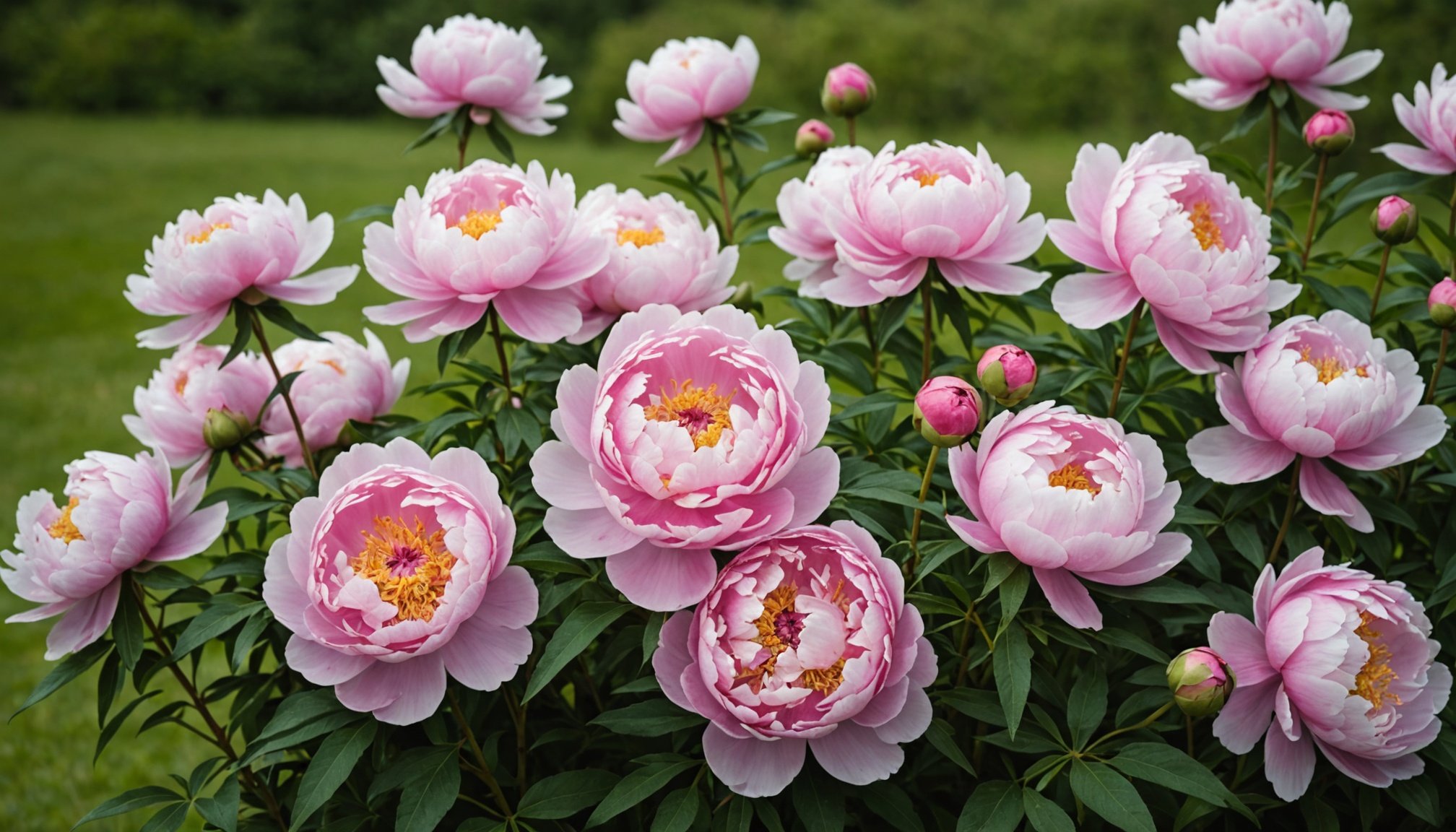Soil Preparation for Peony Cultivation
Preparing the soil correctly is paramount for successful peony growth. Peonies thrive in well-draining soil, which is crucial for preventing root rot. To enhance drainage, consider integrating organic matter such as compost or well-rotted manure into the soil. These soil amendments not only improve structure but also optimize nutrient availability, ensuring healthy peony development.
For optimal growth, the soil pH should range between 6.0 and 7.0. This slightly acidic to neutral pH enhances nutrient absorption and overall plant health. Perform a soil test to determine your garden soil’s pH and adjust accordingly with lime (to raise pH) or sulfur (to lower pH) as needed. These adjustments can significantly enhance peony health by catering to their specific needs.
In the same genre : Ultimate Guide to Transforming Kitchen Waste into Nutrient-Rich Garden Compost in the UK
Understanding different soil types is also essential. Sandy soils may require more organic matter to retain moisture, while clay-heavy soils often benefit from more substantial amendments to improve aeration and drainage. Engage in practical peony growing tips tailored to your soil type to ensure a flourishing peony bed.
In sum, emphasizing well-draining soil and optimal nutrient conditions can significantly impact peony cultivation success. Adjust your approach based on soil composition, and your peonies will thank you with vibrant blooms.
Topic to read : Maximizing Garden Shed Efficiency: Budget-Friendly Insulation Solutions for UK Homeowners
Planting Techniques for Peonies
When planting peonies, attention to planting depth and spacing is crucial for their long-term health. Peonies should be planted so that the eyes (the pink or white buds on the root) are no more than 2.5 to 5 cm below the soil surface. This depth is ideal to ensure proper growth and flowering. Planting them too deeply can result in poor flowering.
Spacing is equally important. Peonies need room to grow and breathe; space them about 90 to 120 cm apart to allow for adequate air circulation. This prevents fungal diseases and promotes robust blooms.
Planting peony tubers is best done in the autumn for optimal root establishment, particularly in humid climates. This timing allows the roots to grow during the cooler months before the stresses of summer heat.
To promote root establishment, ensure young plants are securely covered with soil. This helps prevent exposure to the elements and protects against potential damage. Light mulching can be useful to maintain soil moisture and temperature, supporting healthy establishment. Observing these peony planting tips will set the foundation for a thriving and colorful peony patch.
Watering Practices for Peonies
Establishing effective watering practices is crucial in managing the health of your peonies, especially in humid climates. Understanding the watering needs of peonies in these conditions ensures optimal growth and prevents issues such as root rot. Ideally, water peonies early in the morning, allowing foliage to dry before nightfall. This timing minimizes the risk of fungal diseases.
Irrigation methods should focus on delivering moisture to the root zone while avoiding foliage. Drip irrigation or soaker hoses are excellent choices, providing consistent moisture without the risk of overwatering. Remember, consistent moisture management is key; soil should be moist but not soggy.
Be mindful of both overwatering and underwatering signs. Overwatered peonies often display yellowing leaves and poor growth, while underwatered plants may wilt and have stunted blooms. Adjust your watering routine to accommodate weather conditions and always check soil moisture with a finger test before adding water.
Humidity does not negate the need for watering, but it requires strategic management. By efficiently managing moisture through appropriate irrigation methods, you ensure your peonies thrive and reduce maintenance challenges. Keeping an eye on these details will help you cultivate healthy, flourishing peonies season after season.
Pest Management Strategies
Ensuring effective pest management is essential for maintaining healthy peonies. Common peony pests include aphids, thrips, and fungal infections, each requiring careful identification. Aphids, small green or black insects, often cluster on young shoots, while thrips may cause discoloured streaks on petals. Fungal issues present as gray mould, especially in humid conditions.
For an organic pest control approach, consider introducing beneficial insects like ladybugs or employing insecticidal soaps. Neem oil is also effective against a range of pests without harming beneficial organisms. Regularly cleaning dead foliage can minimise fungal spores, reducing disease incidence.
Monitoring and early intervention are crucial to control pest populations before they become problematic. Inspect plants regularly, focusing on new growth and flower buds, which are more vulnerable. This vigilance allows you to address issues with minimal intervention and maintain the aesthetic and health of peonies.
Implementing these strategies will not only ensure your peonies remain vibrant but also promote environmental health by reducing reliance on chemical treatments. An organic approach to pest management fosters a balanced garden ecosystem, supporting not just peonies but other beneficial garden plants and insects.
Recommended Peony Cultivars for Humid Climates
Choosing the right peony cultivars is vital for successful growth in humid climates like that of the UK. Selecting varieties specifically suited to high humidity can enhance thriving and resilience. Certain peony varieties naturally perform better, offering robust blooms and disease resistance.
Characteristics of Ideal Cultivars:
- Disease Resistance: Look for cultivars bred for resistance to common issues like botrytis blight. Varieties such as ‘Sarah Bernhardt’ and ‘Festiva Maxima’ are well-regarded for their resilience.
- Bloom Duration: Opt for early to late-season bloomers to extend the flowering period. This way, you’ll enjoy vibrant peonies from spring through early summer.
Benefits of Selecting Humidity-Tolerant Varieties:
- Decreased Maintenance: Cultivars suited to humid environments often require less intervention in terms of pest and disease management.
- Enhanced Bloom Quality: These varieties tend to produce more vibrant and full blooms, even amidst challenging climate conditions.
Sourcing Tips:
When sourcing peony cultivars for humid climates, visit local nurseries familiar with the regional climate. Local experts can provide plants acclimated to your area, increasing the likelihood of successful cultivation.
Illustrated Growing Schedules and Challenges
Maintaining a successful growing schedule for peonies requires understanding their seasonal care needs and addressing challenges specific to humid environments. An effective care calendar is pivotal, detailing essential tasks like watering, fertilising, and pest management throughout the year. Spring is dedicated to planting and nourishment, summer focuses on disease management and bloom care, while autumn entails pruning and preparing plants for winter rest.
In humid climates, peonies face challenges, notably root rot and mildew, which can stifle growth and reduce flowering. Employing strategic solutions, such as enhancing soil drainage and ensuring proper air circulation, can mitigate these issues. Use of fungicides and natural remedies, like mixing neem oil, helps maintain plant health and disease prevention.
Understanding bloom times is equally significant. Different cultivars bloom from early to late in the peony season, offering opportunities to sequence plantings for continuous blooms. A well-illustrated guide can assist gardeners in plotting these cycles, ensuring constant garden vibrancy.
For visual learners and amateurs alike, comprehensive guides with imagery and tips enhance understanding. Tailoring care routines to peonies’ unique requirements allows for healthier, more resilient plants, even in challenging humid environments.
Expert Resources and Local Gardening Support
Navigating the world of peony cultivation is made easier with the right resources and support channels. Engaging with gardening resources online offers a wealth of knowledge. Websites and forums provide expert advice, sharing seasonal tips and troubleshooting common issues. Such platforms connect you with a community of enthusiasts and seasoned growers to exchange insights and success stories.
Reaching out to local gardening clubs is particularly beneficial. These groups offer hands-on learning opportunities through workshops and field visits. Engaging with local support not only enhances your understanding but also tailors advice to suit your specific climate and soil conditions, useful in the diverse conditions across the UK.
To deepen your expertise, consider diving into recommended literature on peony care. Books penned by horticulturists often include detailed cultivation techniques and innovative approaches passed down through generations, aiding both novice and seasoned gardeners.
Connecting with community experts, whether through digital networks or in-person gatherings, bolsters confidence and equips you with practical solutions for flourishing peony cultivation. The blend of online communities and face-to-face collaborations ensures you have access to comprehensive and tailored guidance throughout your gardening journey.











